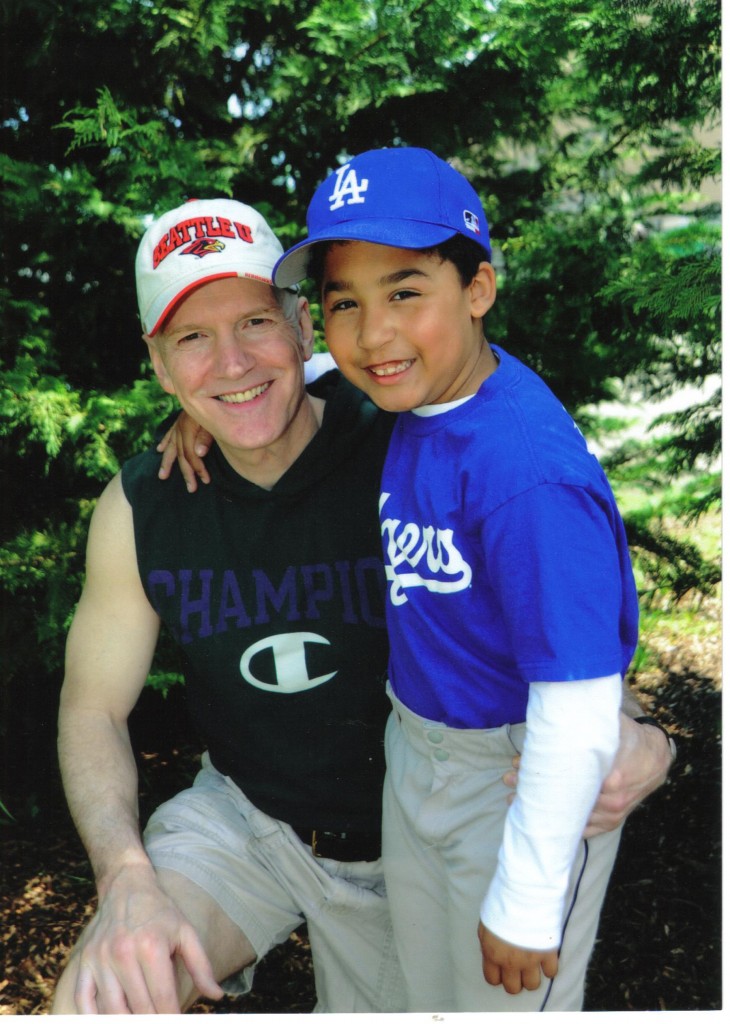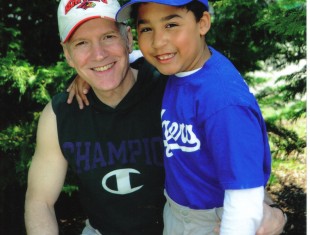CLAY MOYLE AND SON CALEB
As a couple of former high school teammates and I prepare to participate in Hoopfest over in Spokane later this month it occurs to me at age 57 I’ve been playing the sport for just about half a century now. There was a period of about six years (43-49) when I was suffering from arthritis and I was playing very little, but once I received my two hip replacements I discovered a new lease on my basketball playing life and have been going at it pretty hard ever since.
A while back I wrote about the three-point line and the way that has changed the game. But, that certainly isn’t the only change I’ve witnessed. Another is the interpretation of what is, or isn’t traveling.
For a long time now, folks have joked about how much players in the NBA get away with traveling. When I was introduced to the sport, one of the first things we were taught was that anything after a step-and-a-half once you picked up the basketball was traveling.
But, if you spend any time at all watching an NBA basketball game you’ll routinely see players get away with taking not only two full steps, but often as many as three.
And, while that’s been going on in the NBA for a long time now, many folks might be surprised to learn in 2009 the league actually changed their rule concerning traveling. Up until that year, their rulebook said players were only allowed one step. But, in 2009 it was revised to read, “A player who receives the ball while he is progressing or upon completion of a dribble, may take two steps in coming to a stop, passing or shooting the ball.”
For years, I watched former Seattle Sonic guard Dennis Johnson bring the ball up the court, pick up his dribble and take two steps before passing the ball and wondered how he got away with it. But, according to an ESPN article at the time of this official rule change in 2009, the Vice President of referee operations said that the referees had long been instructed to ignore the rulebook on the point and allow two steps. So, all the official rule change did was formalize a practice that had already been in place for many years in the NBA.
So in 2009, the league in which the most talented players in the world compete quietly became the first basketball league in the world to officially allow individuals to take two steps while in the possession of the basketball without dribbling it.
If you’d like to see a perfect example of this and you have internet access I encourage you to go to www.youtube.com and type in either ‘euro step Manu Ginobili’ or ‘euro step Derrick Rose’ and watch the two full steps they take AFTER picking up the basketball when they drive to the hoop. It’s a perfect example of what is legal in the NBA now as opposed to when I was a youngster watching the likes of Jerry West, Walt Frazier and many other great guards.
And who do you think young kids typically choose to emulate when they’re learning to play the game of basketball? Of course, they want to play like the greatest players in the world. They’re going to try and replicate the moves of their favorite NBA players.
I had to laugh recently when I witnessed an opposing player in a recreational league I was participating in get called for traveling.
“But, I only took two steps!” he pleaded to the referee in dismay.
“That’s right, this isn’t the NBA,” he was told.
But, more and more often these days I see players get away with two steps. It wouldn’t surprise me at all if one day all levels of play follow the NBA’s lead and let everyone take two steps. I run into players using the (two-step) euro step move in pick-up games quite a bit these days and none of these guys believe they are traveling.
Another big change I’ve witnessed is an increase in defensive holding. Back in my high school days it was typical to get held by “old guys” in their 30’s or very early 40’s whenever you tried to drive to the hoop. So I came to expect that from older slower guys, but not young players.
I rarely encountered that from a young ballplayer. I just don’t remember being held, or catching a forearm to the side when I attempted to drive around defenders 20 to 40 years ago anywhere near as often as I do today.
Now, part of me wonders if it isn’t the same as it always was, but I’ve slowed down so much that I can’t avoid the holding or forearms to the body that I may have been quick enough to avoid in the past. Maybe that is part of it, but I’m convinced that’s not the whole story and that young players today hold defensively more than ever.
The guys I play against in their twenties and thirties on Saturdays routinely reach out and jam a forearm into your waist or shoulder whenever you try and drive around them toward the hoop. I don’t play that way now, and I certainly didn’t back in the days when I had some speed. Instead, I was taught to move my feet, anticipate the offensive player’s next move and to slide over and try and draw an offensive charge.
Drawing a charge seems to be a bit of a lost art these days. I don’t see it in high school play as often as I did in the past.
But, as I say, it’s not just the older players that I find holding or employing the use of a forearm when someone tries to drive to the hoop against them. Just this past year, I found myself matched up against a young 16-year-old guard on the local high school team on a number of occasions and I’ll be darned if anytime I didn’t drive to the hoop against him I didn’t find myself being held.
About a month ago, I decided that I needed to spend some time figuring out how to counter the tactic so I asked a 27-year-old who plays with us if he’d be willing to spend some time working together on a one-on-one basis. He’s a personal trainer, very quick and physical, and I figured he’d be perfect to practice against.
So, for the past three weeks I’ve been meeting him after work on Fridays. For the first 30 minutes, I position myself at the top of the key and he takes the ball and stands underneath the hoop. Then, he’ll slowly roll the ball toward me, or 10-15 feet to my left or right and sprint out so he’ll be in my face the moment I pick the ball up. At that point, I’ll try and drive on him toward the hoop or to create enough space to get off a jump shot.
Sometimes, I’m successful, sometimes I’m not. He’s very quick and able to recover very quickly anytime I’m able to fake him out. I’ve been trying to improve upon my skills in terms of employing a spin dribble or step back move against him the moment I feel him start to hold, or push me.
It’s very frustrating for me at times. In the old days, many, many years ago, if a defender were to play up so close against me I would have normally found it pretty easy to blow by them. But, those days are long gone. Now, I have to throw a lot more moves at this young man and expend a lot more energy in an attempt to create room for myself to shoot or get to the hoop.
After 30 minutes of that drill I’m exhausted. At that point, we’ll play a single game of one-on-one to 15 to end the workout. So far, I’ve been able to defeat him in those games, partly because we award an extra point for a basket behind the arc and I typically make a few of those each game while he rarely scores from that distance.
This past Friday I invited my teammate Dave Campbell to accompany me to the workout. Before we began, a woman named Jamie Redd approached us from the opposite end of the court. Jamie was a 6’1” forward who played for the Seattle Storm in 2002. She was working with a young girl who appeared to be about 16 years old and another young boy who looked like he was about 12. She wanted to know if we’d be willing to play against them in a game of three-on-three.
We accepted the invitation and I ended up covering the young girl who was clearly being groomed as a post player. At one point, I found myself with the ball on the right wing and decided to give a little fake to my left and then drive the baseline. Well, no sooner did I begin my drive than she delivered a forearm to my left shoulder to impede the drive and push me toward the end line.
Unbelievable, even the young female basketball players are holding or pushing me these days, I thought.
Afterward, when I mentioned the incident to Campbell he told me that anytime there had been a defensive switch and he’d tried to jog across the key she’d stuck a forearm in his chest.
I mentioned the subject to my father over the weekend. He’d assisted with the local girls JV team this past season and he laughingly told me that the head coach taught his girls to pop the opposition with a quick forearm anytime they entered the lane.
Now that’s completely different than the way I played. Whenever I was guarding someone who tried to cut through the lane I used to slide over to block their path and let them run me over in an attempt to draw an offensive charge, or I’d let them bounce off my chest, but I never popped them with a forearm, or used my arm to impede their progress.
To my way of thinking that’s a foul. But, maybe I’m out of touch and that’s the way the game is taught and officiated these days? Either way, it’s the kind of defense I most frequently encounter these days and I find myself trying to adjust accordingly.
If I don’t effectively resolve the issue soon, I may have to contact Marshawn Lynch and see if he’ll work with me on developing a good stiff-arm.



